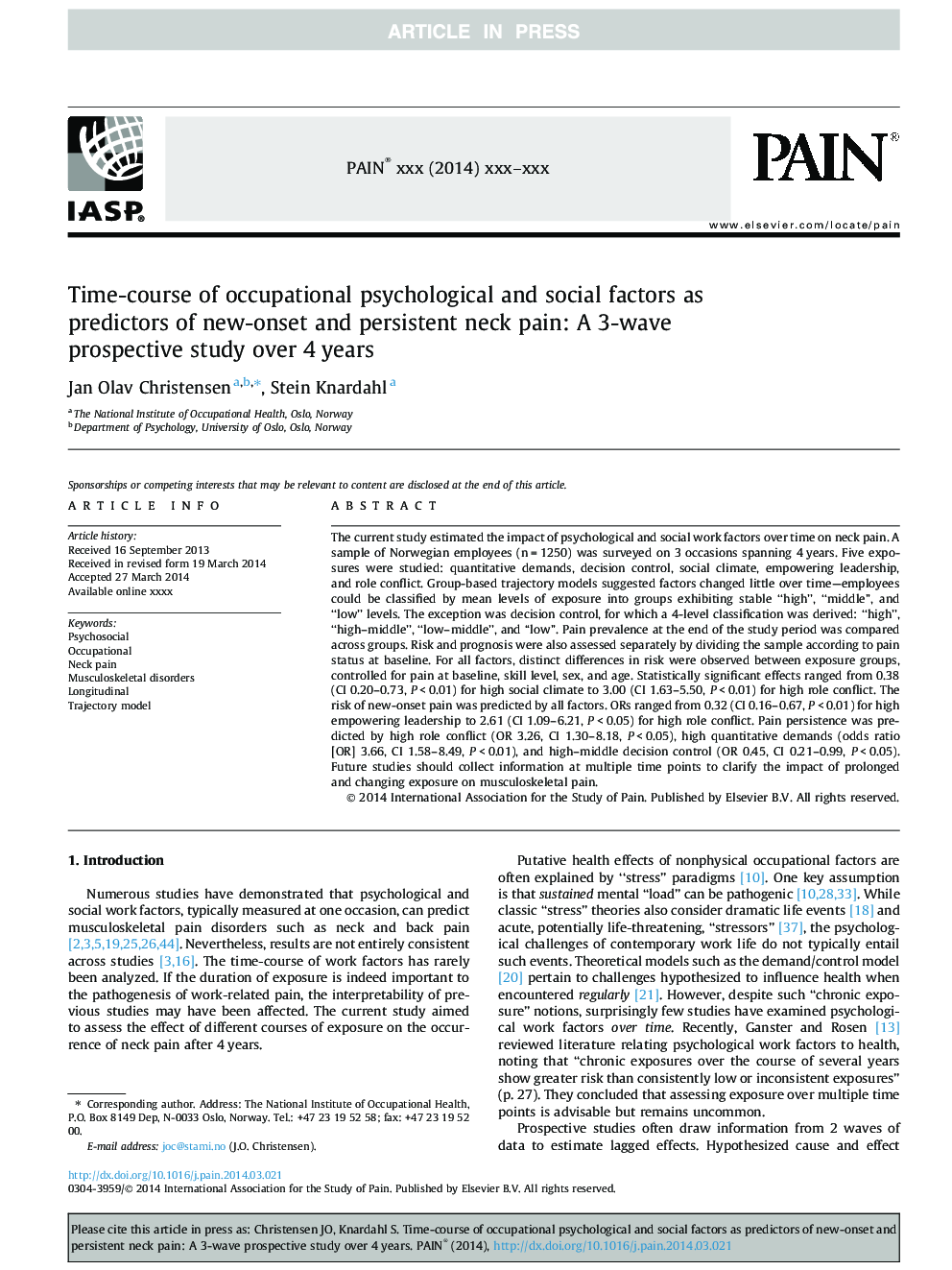| کد مقاله | کد نشریه | سال انتشار | مقاله انگلیسی | نسخه تمام متن |
|---|---|---|---|---|
| 10450503 | 918359 | 2014 | 10 صفحه PDF | دانلود رایگان |
عنوان انگلیسی مقاله ISI
Time-course of occupational psychological and social factors as predictors of new-onset and persistent neck pain: A three-wave prospective study over 4Â years
ترجمه فارسی عنوان
دوره زمانی عوامل روانشناختی و اجتماعی شغلی به عنوان پیش بینی کننده درد نوک مبتلا و مداوم گردن: یک مطالعه آینده نگر در سه ماهه چهار ساله
دانلود مقاله + سفارش ترجمه
دانلود مقاله ISI انگلیسی
رایگان برای ایرانیان
کلمات کلیدی
روانی اجتماعی، شغلی گردن درد، اختلالات اسکلتی عضلانی، طولی مدل مسیریابی،
موضوعات مرتبط
علوم زیستی و بیوفناوری
علم عصب شناسی
علوم اعصاب سلولی و مولکولی
چکیده انگلیسی
The current study estimated the impact of psychological and social work factors over time on neck pain. A sample of Norwegian employees (n = 1250) was surveyed on 3 occasions spanning 4 years. Five exposures were studied: quantitative demands, decision control, social climate, empowering leadership, and role conflict. Group-based trajectory models suggested factors changed little over time-employees could be classified by mean levels of exposure into groups exhibiting stable “high”, “middle”, and “low” levels. The exception was decision control, for which a 4-level classification was derived: “high”, “high-middle”, “low-middle”, and “low”. Pain prevalence at the end of the study period was compared across groups. Risk and prognosis were also assessed separately by dividing the sample according to pain status at baseline. For all factors, distinct differences in risk were observed between exposure groups, controlled for pain at baseline, skill level, sex, and age. Statistically significant effects ranged from 0.38 (CI 0.20-0.73, P < 0.01) for high social climate to 3.00 (CI 1.63-5.50, P < 0.01) for high role conflict. The risk of new-onset pain was predicted by all factors. ORs ranged from 0.32 (CI 0.16-0.67, P < 0.01) for high empowering leadership to 2.61 (CI 1.09-6.21, P < 0.05) for high role conflict. Pain persistence was predicted by high role conflict (OR 3.26, CI 1.30-8.18, P < 0.05), high quantitative demands (odds ratio [OR] 3.66, CI 1.58-8.49, P < 0.01), and high-middle decision control (OR 0.45, CI 0.21-0.99, P < 0.05). Future studies should collect information at multiple time points to clarify the impact of prolonged and changing exposure on musculoskeletal pain.
ناشر
Database: Elsevier - ScienceDirect (ساینس دایرکت)
Journal: PAIN® - Volume 155, Issue 7, July 2014, Pages 1262-1271
Journal: PAIN® - Volume 155, Issue 7, July 2014, Pages 1262-1271
نویسندگان
Jan Olav Christensen, Stein Knardahl,
